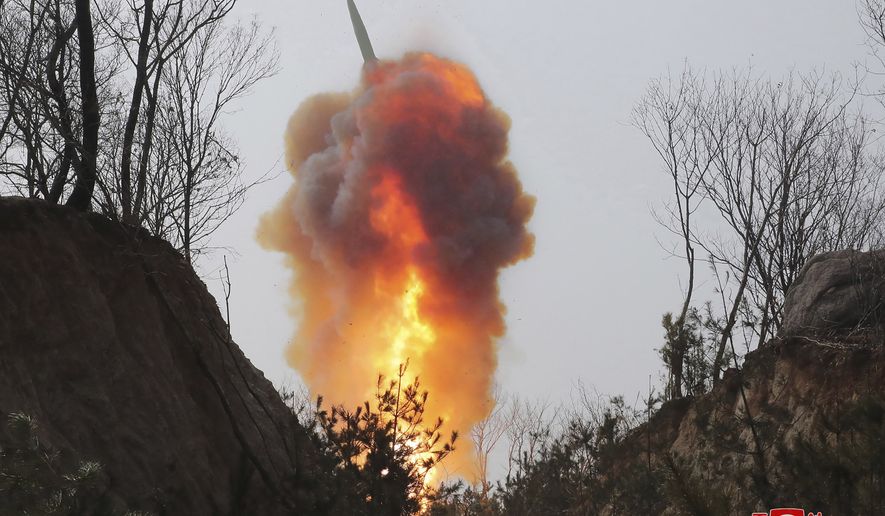SEOUL — Furious over U.S.-South Korean war games it insists are a rehearsal for an invasion, North Korea tested another short-range ballistic missile on Monday which it says is part of a broader push to revamp and sharpen its own warfighting doctrines.
The two-day North Korean exercises, staged amid the revived “Freedom Shield” drills involving U.S. and South Korean forces, included the management of nuclear strike control systems, the transition of troops to a nuclear counterattack posture, and the launching of a tactical ballistic missile tipped with a mock nuclear warhead, monitors in South Korea said.
As is becoming customary, North Korean leader Kim Jong-un and his newly prominent 10-year-old daughter, Ju-ae, oversaw the launch from the country’s northwestern province. The missile flew over North Korean territory and splashed in the Sea of Japan, having traveled 500 miles.
From a state accustomed to unleashing missiles of all types, a short-range ballistic test is not especially noteworthy. But North Korea’s official media stressed that this week’s exercises came with a wider, more comprehensive strategic heft.
Mr. Kim stressed that his forces need to be “familiar with any unexpected circumstances, and … [be] perfectly prepared in their active posture of making an immediate and overwhelming nuclear counterattack anytime,” North Korea’s state-controlled press reported.
To the south, Seoul and Washington are staging the largest annual version of their “Freedom Shield” military exercises since 2017. The drills, which run through Thursday, are aimed at countering the North’s evolving threats. Shortly after the North Korean missile launch was spotted, the U.S. and South Korean militaries were scheduled to conduct large-scale marine landing exercises.
The South Korean drills follow a closed-door tabletop exercise held in the United States in February, which focused specifically on how to respond to a nuclear weapon attack by Pyongyang.
In an eye-catching series of tests last week, the North launched its giant new Hwasong-17 intercontinental ballistic missile and two submarine-launched missiles. It also claimed that some 1.4 million citizens have volunteered for the nation’s military.
But South Korean analysts said the North’s public emphasis on the rewriting of its nuclear protocols and the stress-testing of its missile units marks a distinct shift in the isolated nation’s weapons of mass destruction programs, experts say.
“A threat is a capability and an intention, and North Korea has been working intensively on acquiring capabilities over the past 10 years,” said Daniel Pinkston, a Seoul-based international relations professor at Troy University. “Now it has come to fruition, we are seeing deployment and preparation. the intention part: ’What do you do with it?’”
Many in Seoul fear Mr. Kim could follow Russian President Vladimir Putin’s playbook in Ukraine — launching a conventional invasion bracketed by the threat of a nuclear strike to keep outside states from intervening.
Another possibility is the North could use a smaller, “tactical” nuclear strike to prevent American reinforcements from reaching the peninsula in time.
“U.S. deterrence relies on the ability to air-land a brigade combat team, within days, followed by a division plus within one or two months, and this requires fully functioning and air and sea points of disembarkation,” said David Park, a retired U.S. Army major who has taken part in the annual spring drills. “If these are knocked out, along with major existing U.S. Forces Korea massed formations in the first 24 hours of hostilities, the U.S. counterattack plan needs to be redone.”
U.S. freedom of action might also be restrained by Tokyo, fearing that its own soil could be struck, Mr. Park said. Indeed, regional U.S. troop concentrations — in locations such as Guam, Okinawa and Kadena in Japan, and southern South Korea — are in range of Mr. Kim’s arsenal.
And if the U.S. government countered with its own nuclear strikes, risks to America itself would spiral. “If it is Pyongyang for Washington D.C., is the U.S. up for that?” asked Mr. Park, a Korean American.
Biden administration officials have been seeking to reassure South Korea of the U.S. commitment, deploying B-1 strategic bombers as part of this week’s exercise and reiterating pledges to defend its ally.
The ongoing drills have included the deployment of U.S. B-1 strategic bombers, and repeated a long-standing U.S. message on March 14.
“We have been very clear that were North Korea to employ a nuclear weapon, it would be the end of the North Korean regime,” Pentagon spokesman Brig. Gen. Pat Ryder told a recent briefing.
Chun In-bum, a retired South Korean general, warned that if North Korea launched a nuclear strike, there would be powerful reasons for America to return the destruction — with interest.
“There are around 5,000 [military dependent] U.S. children in South Korea,” he told foreign reporters. “If North Korea killed American children, the wrath of the American people would be terrible.”
Mr. Pinkston, too, is not convinced that U.S. support for South Korea – two nations linked by a mutual defense treaty signed in 1953, the year the Korean War rumbled to an uneasy halt — is weak-kneed.
“If you think you are going to invade South Korea and the U.S. is not going to intervene, you are just mistaken, and the North Koreans know that,” Mr. Pinkston said. “If North Korea nukes Guam, or Kadena or Busan, no American president can sit by and do nothing.”
These risk calculations pose problems for Mr. Kim, who has invested a huge proportion of his state’s economic resources into weapons of limited real-world utility.
Just as nuclear-armed America was unable to prevail against non-nuclear Vietnam, and nuclear-armed Russia is struggling to overcome non-nuclear Ukraine, Mr. Kim’s nuclear arsenal may be equally useless in a conventional war on the divided Korean peninsula.
“Nuclear arms are credible for deterrence,” Mr. Pinkston said. “But nobody has been able to demonstrate how to use nuclear arms for compellence.”
• Andrew Salmon can be reached at asalmon@washingtontimes.com.




Please read our comment policy before commenting.